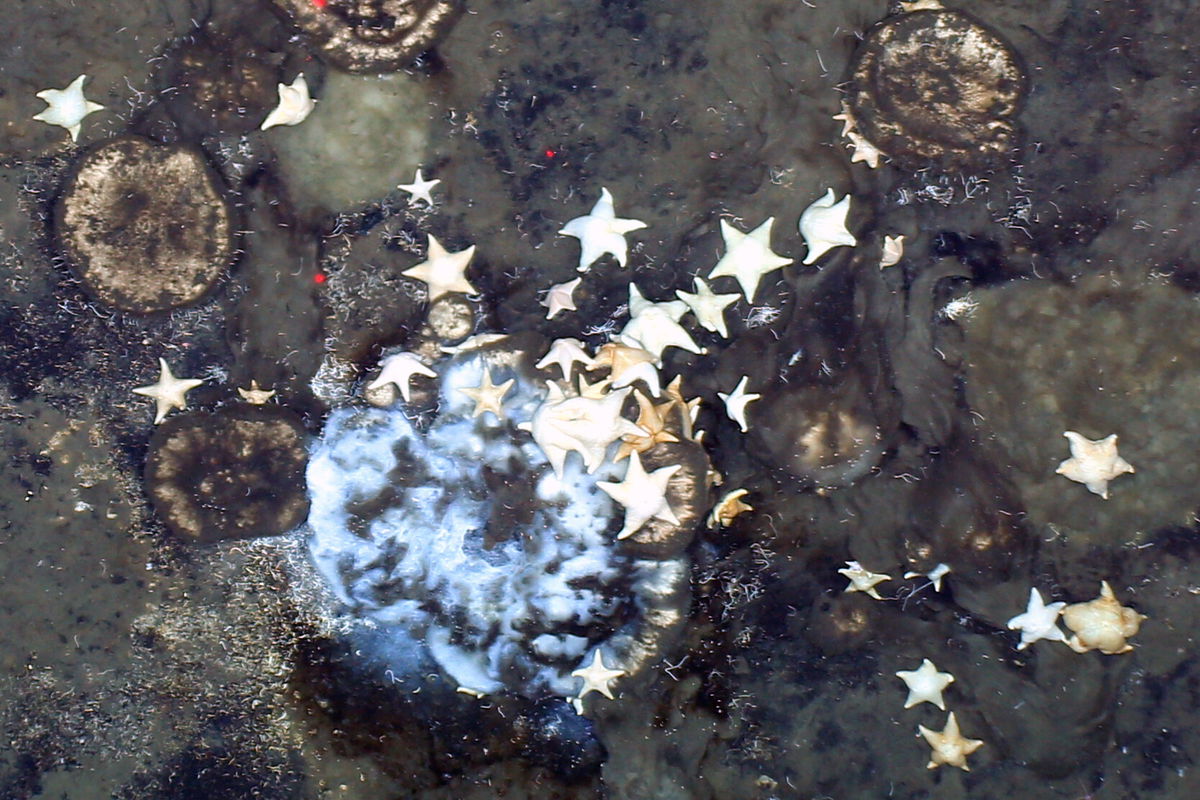Sprawling sponge gardens found deep beneath the Arctic sea ice

Scientists discovered a surprisingly rich and densely populated ecosystem on the peaks of extinct underwater volcanoes in the Arctic deep sea.
By Ashley Strickland, CNN
Deep beneath the ice covering the central Arctic Ocean, an unlikely community thrives off of ancient relics.
Underwater cameras revealed expansive sponge gardens clustered over extinct underwater volcanoes, called seamounts, along the ocean floor.
In order to survive, these largely 300-year-old sponge communities feed off of the fossilized remains of now-extinct animals and fauna. Those creatures likely once relied on the heat and nutrients supplied by the volcanic activity several thousand years ago.
Researchers uncovered this unlikely oasis beneath the ice during an expedition to the area on the famed polar research ship RV Polarstern between September and October of 2016.
While sponges may seem like a simple form of life, they have persisted for millions of years and can be found across the global ocean, from the tropics to the polar regions, with this latest discovery being the most northern location to date, according to the researchers.
To understand the nature of this previously unknown ecosystem, the team analyzed images captured by a towed camera and sonar system, as well as samples collected during the expedition. A study detailing the findings published Tuesday in the journal Nature Communications.
A unique discovery
The central Arctic Ocean, located at the top of the globe, is one of the most remote places on Earth. Few vessels have ever trekked to this area because it’s always covered in ice, but heavy icebreaker ships have managed to explore it.
When the scientists deployed their Ocean Floor Observation Bathymetry System to peer with cameras and sonar beneath the ice, they found an unexplored ecological community. Because of the continuous ice cover, there are few nutrients or food sources.
Finding the sponge community was a complete surprise, according to study author Antje Boetius, chief scientist of the expedition. She is also the head of the Research Group for Deep-Sea Ecology and Technology at the Max Planck Institute for Marine Microbiology and director of the Alfred Wegener Institute at the Helmholtz Centre for Polar and Marine Research.
The sponges vary in size from a few millimeters at the smallest and up to a meter (3.3 feet) in diameter at the largest, with the average measuring about 20 to 30 centimeters (8 to 12 inches) across.
Within the sponges are communities of microbial bacteria. They form a symbiotic relationship because the bacteria help break down the ancient leftovers so the host sponges can obtain nutrients from them.
“This allows them to feed on the remnants of former, now extinct inhabitants of the seamounts, such as the tubes of worms composed of protein and chitin and other trapped detritus,” said first study author Teresa Morganti, a sponge expert from the Max Planck Institute for Marine Microbiology in Bremen, Germany, in a statement.
In turn, the microbes can dissolve the organic matter on the ocean floor and use it as a source of carbon and nitrogen and chemical energy.
The sponges are also the architects of their own ecosystem, producing spicules, or structural elements that form a mat on which they can crawl.
“Sponges play an important role in nutrient and matter cycling by filtering large volume of water,” Boetius and Morganti wrote in an email.
“Sponges are capable of filtering suspended matter from waters and also process dissolved compounds. They can also provide habitat niches for other animals, such as worms which use the sponges as a place on which to develop their tubes, and shrimp to use it as a refuge.”
Ocean extremes
Last year, researchers discovered sponges beneath the Antarctic ice shelves, more evidence that sponges can live in unexpected places.
“Sponges are good at surviving on very low fluxes of food,” Boetius and Morganti wrote.”They are long lived and low energy creatures, so can get by on even the low concentrations of food found under the Antarctic ice shelves. But our find shows that if an additional food source is available, such as the relic remains of the (volcanic) community we observed, the sponge population can blossom to great numbers and biomass.”
The sponge gardens from the new study exist deep beneath the water along the underwater Langseth Ridge, not too far from the North Pole. Their sprawl is comparable to sponge communities found in shallower, more nutrient-rich waters.
“This is a unique ecosystem. We have never seen anything like it before in the high Central Arctic,” Boetius said.
This region, however, is also a part of the globe that feels the most impacts of the climate crisis.
“With sea-ice cover rapidly declining and the ocean environment changing, a better knowledge of hotspot ecosystems is essential for protecting and managing the unique diversity of these Arctic seas under pressure,” Boetius said.
The researchers hope to have the opportunity to investigate how common these relic-utilizing communities are with future expeditions. They also want to understand how the melting of sea ice and increasing temperatures could impact the Arctic sponge gardens and determine if they are able to adapt to such large environmental changes.
The-CNN-Wire
™ & © 2022 Cable News Network, Inc., a WarnerMedia Company. All rights reserved.